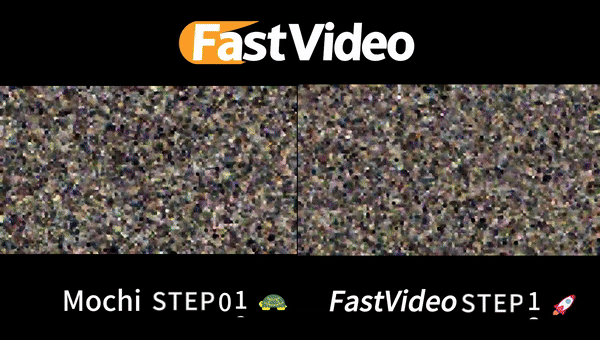FastVideo is a scalable framework for post-training video diffusion models, addressing the growing challenges of fine-tuning, distillation, and inference as model sizes and sequence lengths increase. As a first step, it provides an efficient script for distilling and fine-tuning the 10B Mochi model, with plans to expand features and support for more models.
- FastMochi, a distilled Mochi model that can generate videos with merely 8 sampling steps.
- Finetuning with FSDP (both master weight and ema weight), sequence parallelism, and selective gradient checkpointing.
- LoRA coupled with pecomputed the latents and text embedding for minumum memory consumption.
- Finetuning with both image and videos.
2024/12/17:FastVideov0.1 is released.

|
| Get 8X diffusion boost for Mochi with FastVideo |
Jump to a specific section:
- Python >= 3.10.0
- Cuda >= 12.1
git clone https://github.com/hao-ai-lab/FastVideo.git
cd FastVideo
./env_setup.sh fastvideo
# or you can install the working environment step by step following env_setup.sh
Use scripts/huggingface/download_hf.py to download the hugging-face style model to a local directory. Use it like this:
python scripts/huggingface/download_hf.py --repo_id=FastVideo/FastMochi --local_dir=data/FastMochi --repo_type=modelpython demo/gradio_web_demo.py --model_path data/FastMochi
We also provide CLI inference script featured with sequence parallelism in scripts/inference.
# bash scripts/inference/inference_mochi_sp.sh
num_gpus=4
torchrun --nnodes=1 --nproc_per_node=$num_gpus --master_port 29503 \
fastvideo/sample/sample_t2v_mochi.py \
--model_path data/FastMochi \
--prompt_path "assets/prompt.txt" \
--num_frames 93 \
--height 480 \
--width 848 \
--num_inference_steps 8 \
--guidance_scale 4.5 \
--output_path outputs_video/mochi_sp/ \
--shift 8 \
--seed 12345 \
--scheduler_type "pcm_linear_quadratic"
To reduce the memory cost and time consumption caused by VAE and T5 during distillation and finetuning, we offload the VAE and T5 preprocess media part to the Data Preprocess section. For data preprocessing, we need to prepare a source folder for the media we wish to use and a JSON file for the source information of these media.
We provide a small sample dataset for you to start with, download the source media with command:
python scripts/huggingface/download_hf.py --repo_id=FastVideo/Image-Vid-Finetune-Src --local_dir=data/Image-Vid-Finetune-Src --repo_type=dataset
To preprocess dataset for finetune/distill run:
bash scripts/preprocess/preprocess_mochi_data.sh # for mochi
bash scripts/preprocess/preprocess_hunyuan_data.sh # for hunyuan
The preprocessed dataset will be stored in Image-Vid-Finetune-Mochi or Image-Vid-Finetune-HunYuan correspondingly.
If you wish to create your own dataset for finetuning or distillation, please pay attention to the following format:
Use a txt file to contain the source folder for media and the JSON file for meta information:
path_to_media_source_foder,path_to_json_file
The content of the JSON file is a list with each item corresponding to a media source.
For image media, the JSON item needs to follow this format:
{
"path": "0.jpg",
"cap": ["captions"]
}
For video media, the JSON item needs to follow this format:
{
"path": "1.mp4",
"resolution": {
"width": 848,
"height": 480
},
"fps": 30.0,
"duration": 6.033333333333333,
"cap": [
"caption"
]
}
Adjust the DATA_MERGE_PATH and OUTPUT_DIR in scripts/preprocess/preprocess_****_data.sh accordingly and run:
bash scripts/preprocess/preprocess_****_data.sh
The preprocessed data will be put into the OUTPUT_DIR and the videos2caption.json can be used in finetune and distill scripts.
We provide a dataset example here. First download testing data. Use scripts/huggingface/download_hf.py to download the data to a local directory. Use it like this:
python scripts/huggingface/download_hf.py --repo_id=FastVideo/Mochi-425-Data --local_dir=data/Mochi-425-Data --repo_type=dataset
python scripts/huggingface/download_hf.py --repo_id=FastVideo/validation_embeddings --local_dir=data/validation_embeddings --repo_type=datasetThen the distillation can be launched by:
bash scripts/distill/distill_mochi.sh # for mochi
bash scripts/distill/distill_hunyuan.sh # for hunyuan
- 72G VRAM is required for finetuning 10B mochi model.
To launch finetuning, you will need to prepare data in the according to formats described in section Data Preprocess.
If you are doing image-video mixture finetuning, make sure --group_frame is in your script.
Then run the finetune with:
bash scripts/finetune/finetune_mochi.sh # for mochi
bash scripts/finetune/finetune_hunyuan.sh # for hunyuan
We learned from and reused code from the following projects: PCM, diffusers, and OpenSoraPlan.
